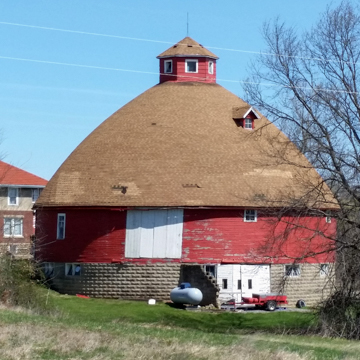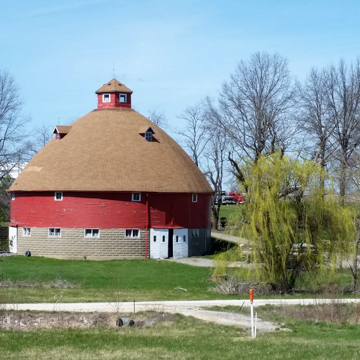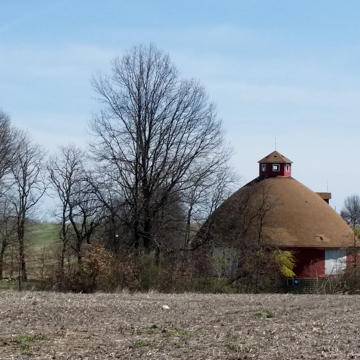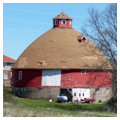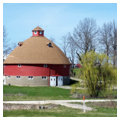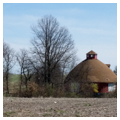This round barn occupies a typical northeastern Missouri farm of the early twentieth century and was constructed by Orie J. Smith, who raised cattle and hogs. Once a center of round and polygonal barns, the midwestern countryside has suffered a notable loss of such structures. Eleven barns concentrated in northern counties have been identified in the state, although the inventory is incomplete. The rare and distinctive design of the Smith barn remains a landmark example, reflecting the skilled carpentry and the progressive ideas of the owner. The bank barn, sixty-four feet in both diameter and height, has a frame of yellow pine and is constructed with a base of rock-faced concrete block. The upper walls are wood, and the barn's tall hexagonal cone-shaped roof is covered with asphalt shingles (originally the shingles were wood). Two small dormer windows pierce the roof and it is crowned with a cupola for ventilation. Round barns were promoted as better at resisting wind loads, for providing more storage capacity than a rectangular barn of the same height, and as cheaper to build because they required less material. Published plans provided basic design information but allowed for endless variations tailored to meet an individual farmer's needs. The chief obstacles to the design's popularity were the ingrained tradition of farmers and carpenters for rectangular barns and their lack of technical skill. As mechanization of farms and the size of farm equipment increased, the rationale for round barns diminished, suited as they were for feeding animals from a central area around the stalls.
You are here
Smith Round Barn
1910–1919, Orie J. Smith. Hwy. P, just north of Round Barn Way, approximately 3 miles northeast of Kirksville
Coordinator:
Osmund Overby, Carol Grove, and Cole Woodcox
If SAH Archipedia has been useful to you, please consider supporting it.
SAH Archipedia tells the story of the United States through its buildings, landscapes, and cities. This freely available resource empowers the public with authoritative knowledge that deepens their understanding and appreciation of the built environment. But the Society of Architectural Historians, which created SAH Archipedia with University of Virginia Press, needs your support to maintain the high-caliber research, writing, photography, cartography, editing, design, and programming that make SAH Archipedia a trusted online resource available to all who value the history of place, heritage tourism, and learning.

